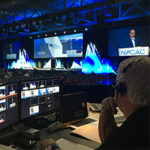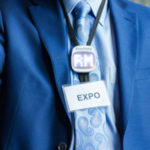
That buzzing sound overhead in the exhibit hall might just be the HVAC system or the lights or a thousand other things you’d expect to find in the arena-like atmosphere of the modern show floor. But it might also be something unexpected: a drone — a compact, remote-controlled, audio- and video-equipped flying vehicle that is a kinder, gentler descendant of the unmanned military aircraft the United States has employed in its global war against terrorism. Increasingly, the meetings industry is turning its attention toward how drones might be incorporated into live events.
While the footage and photos that drones can produce are impressive, the technology isn’t without its areas of contention — from FAA oversight to the safety and privacy of attendees. Don’t let that stop you, though. The following primer will bring you up to speed on everything from trade shows devoted to drones to the true-believer shutterbugs who want to take “aerial selfies” of your attendees, and more.
ATTACK OF THE DRONES
Drones go by many names, depending on whom you talk to and in what context. Those who work closely with the devices, and who want to avoid the political implications of the word “drone” — which can conjure images of high-altitude terrorist strikes and spying — tend to go with “unmanned aerial vehicles,” or UAVs. Others refer to them, cutely, as “hover cams” or “quadcopters,” since they’re little more than remote-controlled model helicopters equipped with cameras.
In terms of meetings and events, we’re mostly talking about some form of hover cam. Indeed, these drones are about as far away from those used by the U.S. military as a toy car is from a real one. But the technology is relatively new, and people can still have knee-jerk reactions. “It’s an emotionally charged thing,” said Eric Eden, vice president of marketing for Cvent, which used a video-camera–equipped drone at a recent meeting.
One group with perhaps the longest view of drone technology is the Association for Unmanned Vehicle Systems International (AUVSI). The association was founded toward the end of the Vietnam War, in 1972, near Patterson Air Force Base in Dayton, Ohio — where many early drones were tested. AUVSI, whose annual Unmanned Systems show began a year later, was created to promote and advance the nascent drone industry, according to Staci Butler, the association’s vice president of conference and expo services. The show has always focused primarily on defense and commercial purposes, and in the past few years has experienced a turn toward the latter — as well as explosive growth. In 2002, Unmanned Systems had 1,600 attendees and 105 exhibitors; the most recent version, this past May 12–15 at the Orange County Convention Center in Orlando, drew 8,000 attendees and more than 600 exhibitors.
Unmanned Systems’ program combines general sessions with keynote speakers — this year’s included Lt. Gen. Kevin W. Mangum, deputy commanding general and chief of staff for the U.S. Army Training and Doctrine Command, and U.S. Rep. Frank LoBiondo, a member of the Congressional Unmanned Systems Caucus — with panels, workshops, technical sessions, poster papers, and “Beyond the Booth” sessions on the show floor, where exhibitors can give talks and product demonstrations. Although AUVSI hasn’t used drones for event photography at Unmanned Systems, it does have a netted-in area on the show floor, roughly 50 feet by 100 feet, for air and ground demonstrations. (The association focuses on any unmanned vehicles, not just flying drones.) Exhibitors get blocks of time during which to demonstrate their products, sometimes sending drones into the air to land them on various perches — or even, in the case of a company called Parrot, choreographing a drone-based musical number.
Unmanned Systems isn’t the only player in the rapidly expanding world of UAV events. Others that have popped up in recent years include the Silicon Valley Drone Show (sUSB), the Drones & Aerial Robotics Conference (DARC), and the International Conference on Unmanned Aircraft Systems (ICUAS).
PRIVACY, SAFETY, AND THE FAA
Many education sessions at the Unmanned Systems show are increasingly oriented toward two hot-button issues in the world of drones, according to Butler: privacy and Federal Aviation Administration (FAA) regulations. Privacy, of course, is not much of a concern when it comes to drones being used for event photography at meetings. Attendees are used to having their picture taken — and most events, as part of registration, require people to acknowledge that they’re aware of this practice and approve of their likeness being used in promotional photos or videos.
That said, given the newness of drone technology, Cvent’s Eden says it’s a good idea to give attendees a heads-up when drones are being used at an event. “You just have to be clear about what [the technology] is,” Eden said. “This is just a better way to do photography at events.”
But it’s not necessarily a safer way. Rarely has a hotel-ballroom air-conditioning unit kicked on and propelled an event photographer headfirst into a smiling group of attendees. However, that’s exactly the sort of mishap that can occur with drones, especially those piloted by a novice operator. “It’s good to have someone who’s experienced using them, just for safety reasons,” Eden said. “We actually bought [a drone] for our professional video team to use, and it took them some good practice to learn how to use it.”
Eden also brings up the hit YouTube video (nearly 10 million views and counting) of a pilot flying a drone through a fireworks display, which — while admittedly stunning — later gave some spectators cause for complaint.
“What if [the drone] got hit [by a firework] and fell on someone?” Eden said. “You have to think of attendees’ safety.” Cvent did just that when it decided to use a drone to create video footage at its 2014 Corporate Meetings Summit, held this past June 18–20 at The Venetian and The Palazzo in Las Vegas. It asked drone operator BUZZair — run by redbutton.tv’s Sam Stanton — to restrict flights to over the stage area rather than the audience itself.
It goes without saying you must make your venue aware of any plans to use drones. When the National Association of Broadcasters (NAB) introduced them for the first time at the 2014 NAB Show, held at the Las Vegas Convention Center (LVCC) on April 5–10, “We had to talk to convention-center management and let them dictate what was safe,” said Jake Zatzkin, NAB’s digital strategies marketing manager. The NAB Show “is all about content,” Zatzkin said, “and drones are a new and exciting kind of content capture.” The LVCC said that it would allow drones to fly through the exhibit hall only at night, after the show’s 98,000 attendees had cleared out. NAB used the footage shot during those flights — also conducted by Stanton and BUZZair — for its B-roll needs. Next year, the NAB Show will for the first time have an indoor, netted-in Drone Pavilion on its show floor, in order to demonstrate one of the hottest content-creation devices available to broadcasters. It’s not being done without caution, though. “We are going into it with the same safety precautions and regulations that are put on the exhibitors [by both NAB and the LVCC],” Zatzkin said.
One aspect of drones that is far less clear, at least when it comes to outdoor usage, is the FAA’s position. “It is very much a gray area,” said Dan Gettinger, co-director of the Center for the Study of the Drone at Bard College in New York state. “And it’s not being helped at all by the direction the FAA is taking toward the issue of commercial drone use.” Yet that’s not stopping many companies, including Amazon.com and Disney, from dreaming up fantastical ways in which to use UAVs. One of those is Amazon’s Prime Air, which promises to deliver items from the online retailer via flying drone within 30 minutes. Amazon petitioned the FAA this past July to allow it to put Prime Air into practice, and says in an FAQ on its website: “We hope the FAA’s rules will be in place as early as sometime in 2015. We will be ready at that time.”
Whether or not the FAA is ready is another story. Via a 2007 “Notice of Policy,” the FAA banned entirely the commercial use of drones. According to “Busting Myths About the FAA and Unmanned Aircraft,” a document available on FAA.gov, the ban is within the agency’s authority because the FAA is responsible “for the safety of U.S. airspace from the ground up.” Furthermore, the document states that a popular misconception that the FAA does not control airspace below 400 feet “may originate with the idea that manned aircraft generally must stay at least 500 feet above the ground.”
The agency has attempted to enforce its ban via the use of cease-and-desist letters, as well as, in the case of Raphael Pirker — who in 2011 flew a drone around the campus of the University of Virginia to make a promotional video — a citation and a $10,000 fine. The FAA accused Pirker of “operat[ing] the flight … for compensation” and “in a careless or reckless manner so as to endanger the life or property of another.”
Pirker contested the case, and this past March an administrative law judge ruled in his favor, agreeing with Pirker’s argument that the FAA’s Notice of Policy did not constitute a legally binding regulation. The FAA has appealed the ruling to the National Transportation Safety Board, whose decision is expected this fall. Meanwhile, outdoor drone usage remains an unsettled legal area, and meeting planners who choose to do so should know that they could run afoul of the FAA.
ABOVE IT ALL
The most prevalent way in which drones are being used at meetings and events is to provide photography and videography with unique perspectives that likely couldn’t be captured outside of expensive helicopter shots. That’s why Cvent had a drone at this year’s Corporate Meetings Summit. “We’re fans of technology,” Eden said. “We thought it would be a cool dynamic at the show, and it gave us some awesome footage that was able to better show the atmosphere.”
Cvent had BUZZair fly the UAV before its opening keynote, during a performance by the comedy troupe Improv Everywhere. The drone was able to capture an interesting point of view, creating scenes that Cvent incorporated into its event video coverage. Attendees were impressed. “Our audience of professional meeting planners thought it was something cool that they hadn’t seen before,” Eden said, “and a lot of them were very interested in how it works and thinking about how they could do something [similar] at one of their meetings and events.” During the show, BUZZair staffers were at Cvent’s Innovation Pavilion, so they could show planners how the drone works.
Obviously, Stanton himself is a big booster of the technology, especially because of the unfamiliar point of view it can provide. “Drones are wicked crazy cool,” he said. “When they go up, everyone loses their mind. But the real cool thing is the footage you get. The mind is used to seeing images up to 20 feet [in the air], like on a jib [camera boom], or from down to about 500 feet in a helicopter. So when you break those boundaries, people go, ‘Wow, what just happened?’”
Meeting-technology consultant Corbin Ball, CSP, CMP, DES, got to see a drone in action at the SITE Texas Technology Summit 2014 this past May 1–4, at the Hard Rock Hotel Riviera Maya. “It’s stunning when you look at some of this stuff,” Ball said. “[Footage shot from a drone] looks like a professional helicopter film crew — but for way, way cheaper, and inside as well.”
But is it worth the extra effort and expense? Maybe. The technology is still new and exciting, making it that much more likely that attendees will share drone-shot photos and footage on social media, in turn helping build attendance at the next iteration of the show. That’s a big part of BUZZair’s sales pitch: the “post and boast” appeal of drone footage. Stanton said: “Any event planner’s goal is that you go home and tell five or 10 people how great the event was.”
SOARING SITE VISITS
Another new way in which the meetings industry is utilizing drones is with virtual site visits. In May, for example, Freeman announced drone-based enhancements to PLANTOUR, its web-based site-inspection tool. Using drones to film venues “gives more of an opportunity to capture the facility from different perspectives,” said William Collins, Freeman’s vice president of product development, “and allows us to capture both internal and external views at a lower cost.”
Freeman began filming facilities with drones in March, and has immediate plans to shoot 15 to 20 venues “that host our biggest customers,” according to Collins. They include the LVCC, Mandalay Bay Convention Center, and Sands Expo and Convention Center in Las Vegas; the Jacob K. Javits Convention Center in New York City; McCormick Place in Chicago; Denver’s Colorado Convention Center; and headquarters hotels such as the Omni Dallas. Although Freeman would like to have the project completed sooner, the company expects to finish filming within 12 to 18 months, simply because of the availability of the venues. “When trying to capture a venue for planning purposes,” Collins said, “we want to capture them empty.”
While a planner viewing one of the videos won’t actually be able to control the drone’s virtual flight path, Collins said, “We believe that from a drone perspective, you get a more seamless approach to how you view the facility.” Nevertheless, he doesn’t think drone video will ever replace the in-person site visit — but it “might eliminate the second, third, and fourth site visit,” he said. “There’s just something about a true fly-through.”



